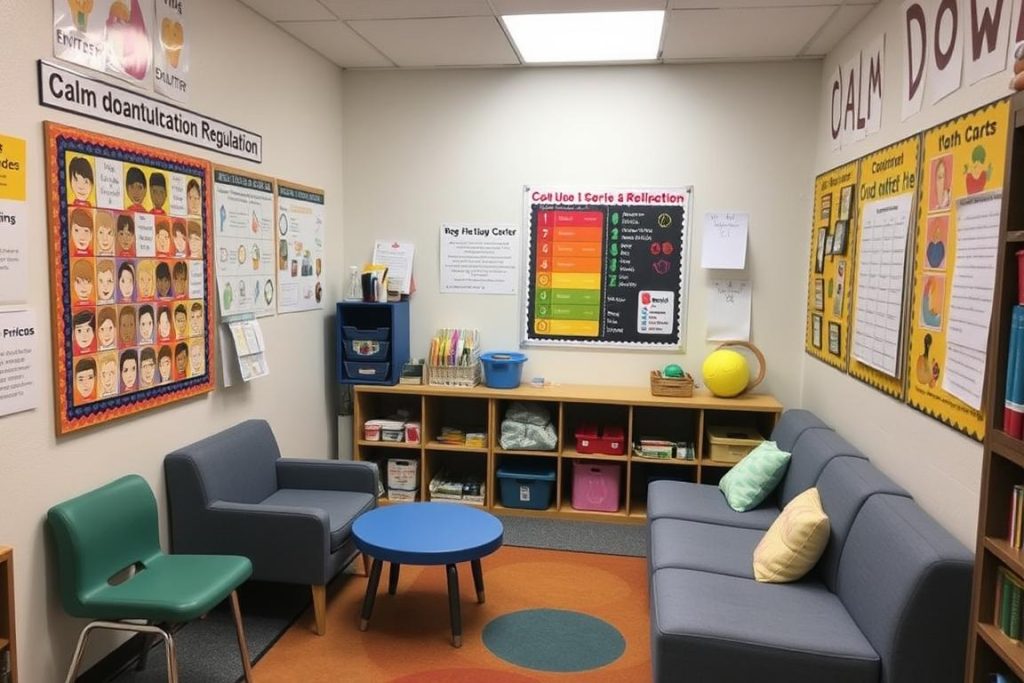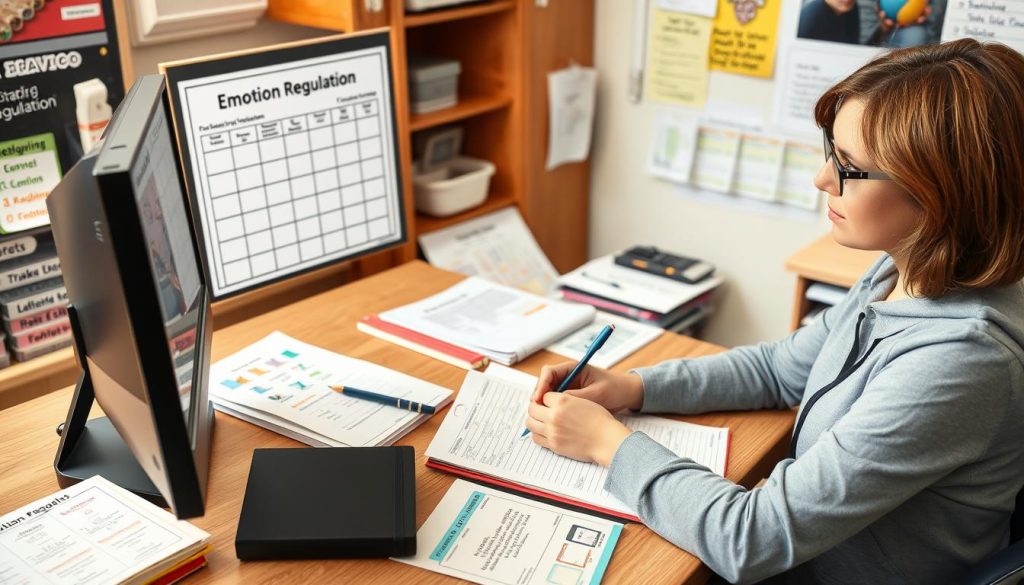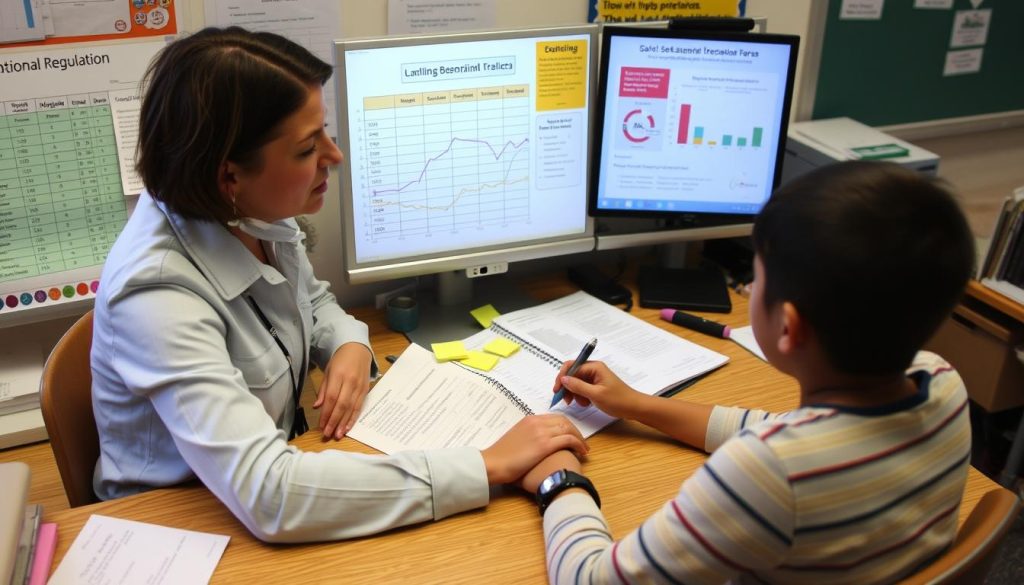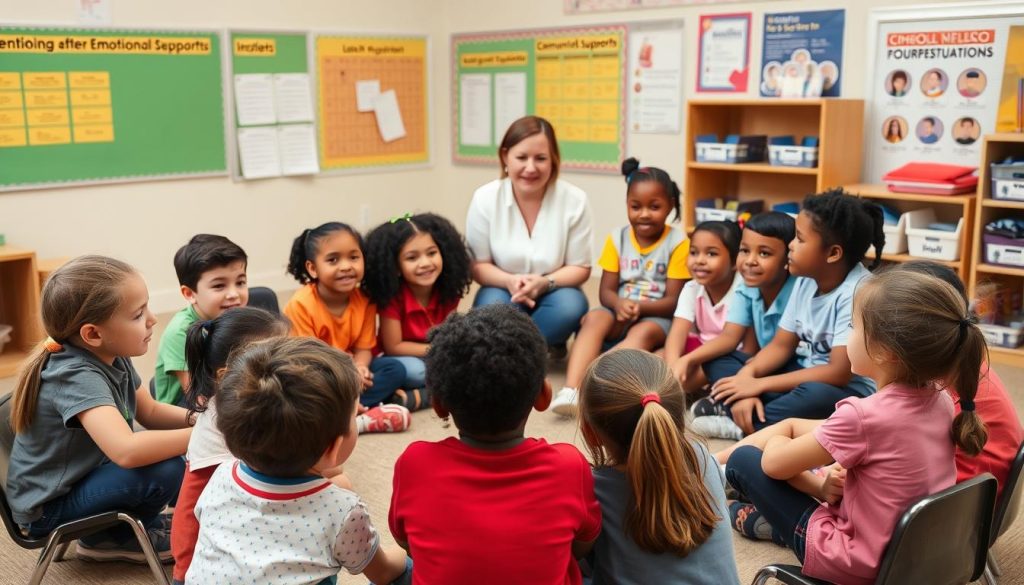Why Emotional Regulation Matters in Classroom Discipline
Traditional classroom management often focuses solely on controlling behavior through rewards and consequences. While these approaches can be effective in the short term, they miss a crucial element: the emotional foundations of behavior. Students who act out are frequently struggling with emotions they don’t understand or can’t control.
Emotional regulation refers to our ability to manage our emotional responses in healthy ways. For students, this skill is still developing, and many disruptive behaviors stem from underdeveloped regulation abilities. When we incorporate emotional regulation into our discipline approach, we address both the immediate behavior and the underlying emotional needs.
Research shows that students with strong emotional regulation skills demonstrate:
- Better academic performance
- Improved peer relationships
- Greater resilience when facing challenges
- Reduced instances of disruptive behavior
- Higher levels of engagement in learning activities
By teaching and modeling emotional regulation as part of your discipline strategy, you’re not just managing your classroom more effectively—you’re equipping students with essential life skills. As educational research has consistently shown, these social-emotional skills are as important for long-term success as academic knowledge.
Understanding the Connection Between Emotions and Behavior
Before we can effectively combine emotional regulation with discipline, we need to understand how emotions drive behavior in the classroom. The brain’s emotional centers can override rational thinking, especially in children whose prefrontal cortex (responsible for decision-making and impulse control) is still developing.
The Emotional Brain in Action
When a student feels threatened, anxious, or overwhelmed, their amygdala (the brain’s alarm system) activates, triggering a fight, flight, or freeze response. In the classroom, this might look like:
- Arguing or talking back (fight)
- Running out of the room or avoiding work (flight)
- Shutting down or refusing to participate (freeze)
Traditional discipline that focuses only on the behavior without addressing the emotional state can actually intensify these reactions, creating a cycle of escalating behavior problems.
Signs of Emotional Dysregulation
Learning to recognize when students are struggling with emotional regulation is the first step in providing appropriate support. Watch for these indicators:
- Rapid changes in mood or behavior
- Physical signs like flushed face, rapid breathing, or fidgeting
- Disproportionate reactions to minor frustrations
- Difficulty transitioning between activities
- Withdrawal from social interactions
Understanding this connection helps us see that many “discipline problems” are actually regulation problems. When we reframe our perspective this way, we can develop more effective interventions that address both the behavior and its emotional roots.
Practical Emotional Regulation Strategies for the Classroom
Integrating emotional regulation into your classroom discipline approach doesn’t require a complete overhaul of your management system. Instead, you can incorporate these practical strategies alongside your existing practices to create a more comprehensive approach.
Co-Regulation Techniques
Co-regulation occurs when an adult helps a child manage their emotions through supportive interactions. This is especially important for younger students who haven’t yet developed independent regulation skills.
- Use a calm, steady voice when a student is upset
- Offer physical proximity without crowding
- Model deep breathing or other calming techniques
- Validate feelings while setting boundaries on behavior
- Provide simple choices to restore a sense of control
Creating Regulation Spaces
Designated spaces where students can go to manage overwhelming emotions provide a proactive approach to emotional regulation.
- Set up a “peace corner” or “calm-down spot” in your classroom
- Stock with sensory tools like stress balls, fidgets, or weighted items
- Include visual reminders of calming strategies
- Establish clear guidelines for using the space
- Frame it as a positive tool, not a punishment
Emotional Vocabulary Building
Students who can name their feelings are better equipped to manage them. Expanding emotional vocabulary is a foundational regulation skill.
- Use emotion charts with varied feeling words
- Practice identifying emotions in stories and situations
- Model naming your own feelings appropriately
- Create opportunities for students to express emotions in safe ways
- Acknowledge the full range of emotions as normal and acceptable

Ready to transform your classroom management approach?
Discover research-backed strategies for effective discipline that incorporate emotional regulation techniques. Our comprehensive resources help you create a more positive, regulated classroom environment.
Integrating Emotional Regulation into Your Discipline System
The most effective approach combines proactive emotional regulation teaching with responsive discipline strategies. Here’s how to create a comprehensive system that addresses both behavior management and emotional skill development.
The Regulation-Before-Correction Approach
When behavioral issues arise, follow this sequence to integrate emotional regulation into your response:
- Regulate first: Help the student return to a calm state before addressing the behavior
- Relate: Reconnect with the student through empathy and understanding
- Reason: Once calm, discuss the behavior and more appropriate choices
- Restore: Guide the student in making amends if necessary
- Reflect: Help the student identify triggers and plan for next time
Tiered Support for Emotional Regulation
Just as with academic content, students need different levels of support for emotional regulation:
| Support Tier | For Which Students | Regulation Strategies | Discipline Integration |
| Tier 1 (Universal) | All students | Class-wide emotional vocabulary, calm-down strategies, regular check-ins | Proactive reminders, visual cues, class meetings |
| Tier 2 (Targeted) | Students needing additional support | Small group instruction, check-in/check-out systems, emotion coaching | Behavior contracts with regulation goals, scheduled breaks |
| Tier 3 (Intensive) | Students with significant regulation challenges | Individual intervention plans, collaboration with counselors, personalized regulation tools | Functional behavior assessment, individualized discipline approach |
This tiered approach ensures that all students receive appropriate support for developing emotional regulation skills while maintaining clear behavioral expectations. For more detailed guidance on implementing tiered behavioral supports, explore the professional development resources available through Credits for Teachers.
Teacher Emotional Regulation: The Foundation of Effective Discipline
Perhaps the most overlooked aspect of classroom management is the teacher’s own emotional regulation. Students learn more from what we model than from what we say, making our self-regulation crucial to an effective emotional approach to discipline.

Why Teacher Regulation Matters
When we remain regulated in challenging situations, we:
- Model appropriate emotional responses
- Make better disciplinary decisions
- Maintain positive relationships with students
- Create a safer emotional climate in the classroom
- Prevent power struggles and escalation
Teacher Regulation Strategies
Develop your own regulation toolkit with these practices:
- Identify your emotional triggers in the classroom
- Practice quick reset techniques (deep breathing, grounding)
- Use positive self-talk during challenging moments
- Take brief breaks when possible (even 30 seconds helps)
- Develop supportive connections with colleagues
“The most powerful tool in classroom management is not the consequence system or reward chart—it’s the teacher’s ability to remain regulated while helping students develop their own regulation skills.”
Dr. Lori Desautels, Educational Neuroscience Specialist
Remember that your regulation affects the entire classroom climate. Taking care of your emotional needs isn’t selfish—it’s an essential part of effective teaching and classroom management. For more strategies on maintaining your own emotional well-being as an educator, check out the teacher well-being resources from CASEL.
Emotional Regulation in Action: Classroom Case Studies
Seeing how other teachers have successfully integrated emotional regulation into their discipline approaches can provide valuable insights. Here are three real-world examples from different grade levels:
Elementary: Ms. Johnson’s Morning Check-In System
After noticing that transitions from home to school were triggering behavioral issues, Ms. Johnson implemented a simple emotional check-in system:
- Students place their name magnet on an emotion chart upon arrival
- Teacher briefly connects with students in “yellow” or “red” zones
- Class begins with a 3-minute regulation activity based on overall needs
- Students can update their status throughout the day
Result: Morning disruptions decreased by 60%, and students began independently using regulation strategies when upset.
Middle School: Mr. Rivera’s Regulation Stations
To address the unique emotional challenges of adolescence, Mr. Rivera created regulation stations in his classroom:
- Four discreet stations with different regulation tools
- Students use hand signals to request a brief station break
- Each station includes written prompts for reflection
- Behavior discussions happen after regulation, not during emotional moments
Result: Students became more aware of their emotional states and proactively used regulation strategies, reducing office referrals by 40%.
High School: Ms. Taylor’s Regulation-Infused Consequences
Ms. Taylor redesigned her consequence system to incorporate emotional regulation:
- Replaced detention with “reflection sessions” focused on emotional awareness
- Incorporated brief regulation practices at the start of each class
- Used collaborative problem-solving for repeated behavior issues
- Taught specific regulation strategies for test anxiety and peer conflicts
Result: Improved classroom climate and student reports of feeling more supported, with 85% of students using regulation strategies independently by year-end.
These examples demonstrate that emotional regulation can be successfully integrated into discipline systems across all grade levels. The key is consistency, explicit teaching of regulation skills, and maintaining clear behavioral expectations while supporting emotional development.
Step-by-Step Implementation Guide for Emotional Regulation in Discipline
Ready to transform your approach to classroom discipline? This implementation guide will help you integrate emotional regulation strategies systematically.

- Assess your current approach: Reflect on your existing discipline system. Which aspects work well? Where do students struggle with emotional regulation?
- Start with self-regulation: Develop your own regulation practices before introducing them to students.
- Create a regulation-friendly environment: Designate calm spaces and provide visual supports for emotional awareness.
- Teach regulation explicitly: Dedicate time to teaching specific regulation strategies, just as you would academic content.
- Revise your response protocol: Implement the regulate-relate-reason-restore-reflect sequence when addressing behavior.
- Communicate with families: Share your approach with parents and provide consistent language they can use at home.
- Monitor and adjust: Collect data on both behavior incidents and regulation strategy use to guide refinements.
Implementation Tip: Start small! Choose one or two emotional regulation strategies to integrate into your existing system rather than overhauling everything at once. This allows both you and your students to adjust gradually while seeing immediate benefits.
Need support implementing these strategies?
Access comprehensive resources, printable materials, and professional development opportunities designed specifically for K-12 teachers integrating emotional regulation into classroom discipline.
Overcoming Common Challenges to Emotional Regulation Approaches
While integrating emotional regulation into discipline offers tremendous benefits, teachers often encounter challenges during implementation. Here’s how to address the most common obstacles:
Challenge: Time Constraints
Solution: Integrate brief regulation practices into existing routines:
- 30-second breathing exercises during transitions
- Emotion check-ins alongside academic check-ins
- Teach regulation strategies through content (literature, history)
- Use visual cues that don’t require teacher facilitation
Challenge: Resistance to Change
Solution: Address concerns with evidence and gradual implementation:
- Share research on emotional regulation and academic success
- Start with one strategy and document positive results
- Maintain clear boundaries while adding regulation support
- Involve resistant stakeholders in planning and evaluation
Challenge: Students Using Regulation as Avoidance
Solution: Create clear structures and expectations:
- Establish time limits for regulation breaks
- Teach the difference between avoidance and regulation
- Create return-to-task routines after regulation activities
- Use visual timers and transition warnings
Challenge: Inconsistent Implementation
Solution: Build systems for consistency:
- Create visual reminders of regulation protocols
- Develop a shared language across classrooms
- Schedule regular reflection on implementation
- Partner with colleagues for mutual accountability
Remember that implementing any new approach takes time and adjustment. Be patient with yourself and your students as you develop these new skills together. The initial investment in teaching emotional regulation pays dividends in reduced discipline issues and improved classroom climate over time.
Measuring Success: Evaluating Your Emotional Regulation Approach
How do you know if your integrated approach to emotional regulation and discipline is working? Looking beyond simple behavior counts to more comprehensive measures provides a fuller picture of impact.
Indicators of Success
Consider tracking these metrics to evaluate the effectiveness of your approach:
Quantitative Measures
- Reduction in office referrals and discipline incidents
- Decreased time spent addressing behavior issues
- Increased academic engagement time
- Improved attendance rates
- Student self-reports of emotional awareness (pre/post surveys)
Qualitative Indicators
- Students independently using regulation strategies
- More nuanced emotional vocabulary in student discussions
- Improved quality of peer conflict resolution
- Student ability to identify triggers and patterns
- Positive shifts in classroom climate and relationships
Simple Data Collection Methods
You don’t need elaborate systems to track progress. Consider these practical approaches:
- Keep a tally of regulation strategy use (by you and students)
- Use exit tickets that include emotional check-ins
- Take brief notes on specific student regulation growth
- Create a simple spreadsheet tracking behavior incidents before and after implementation
- Collect student reflections on their emotional awareness periodically

The most meaningful evaluation combines multiple data sources and focuses on growth over time rather than perfection. Share your findings with students, celebrating improvements and collaboratively setting new goals for emotional regulation and positive behavior.
For more comprehensive assessment tools and strategies, explore the evaluation resources available through the Effective Discipline program.
Conclusion: The Transformative Power of Emotional Regulation in Discipline
Integrating emotional regulation into your classroom discipline approach represents a significant shift from traditional behavior management. Rather than simply controlling student behavior, this approach develops essential life skills while creating a more positive, productive learning environment.
When we combine emotional regulation with discipline, we:
- Address the root causes of challenging behaviors
- Teach students skills they’ll use throughout their lives
- Create stronger, more trusting teacher-student relationships
- Reduce time spent on behavior management
- Improve the overall classroom climate for learning
Remember that this integration is a journey, not a destination. Start with small changes, celebrate progress, and continue refining your approach based on what works for your unique classroom community.

By investing in emotional regulation as a cornerstone of your discipline approach, you’re not just creating a better-managed classroom—you’re helping shape emotionally intelligent individuals prepared to navigate life’s challenges with resilience and self-awareness.
Ready to transform your classroom management approach?
Access comprehensive resources, professional development opportunities, and a supportive community of educators implementing emotional regulation strategies in their classrooms.




